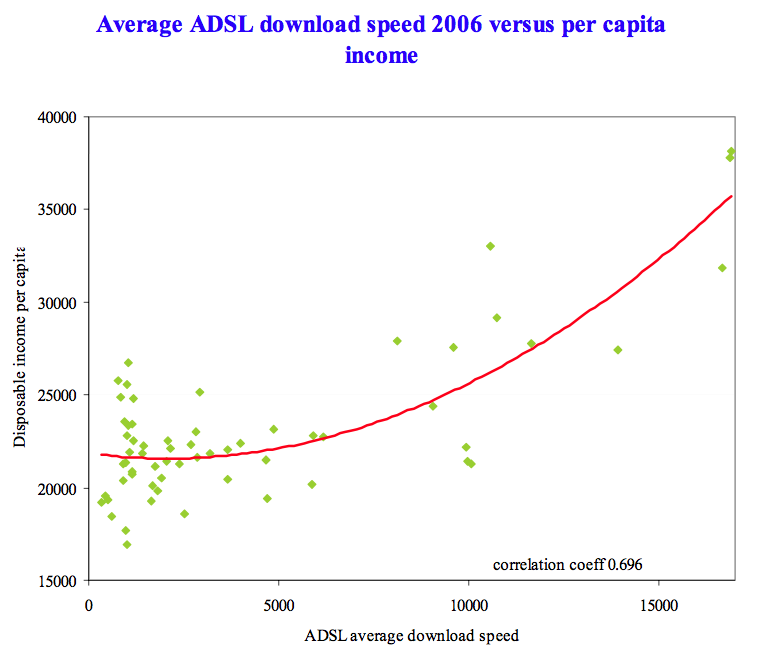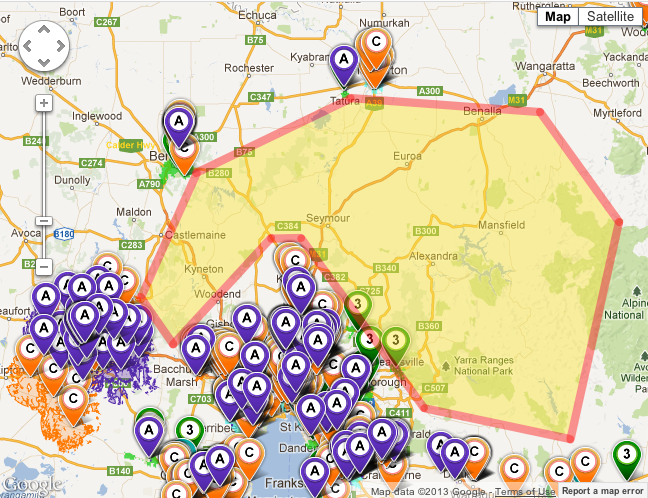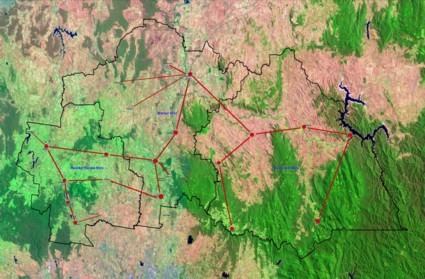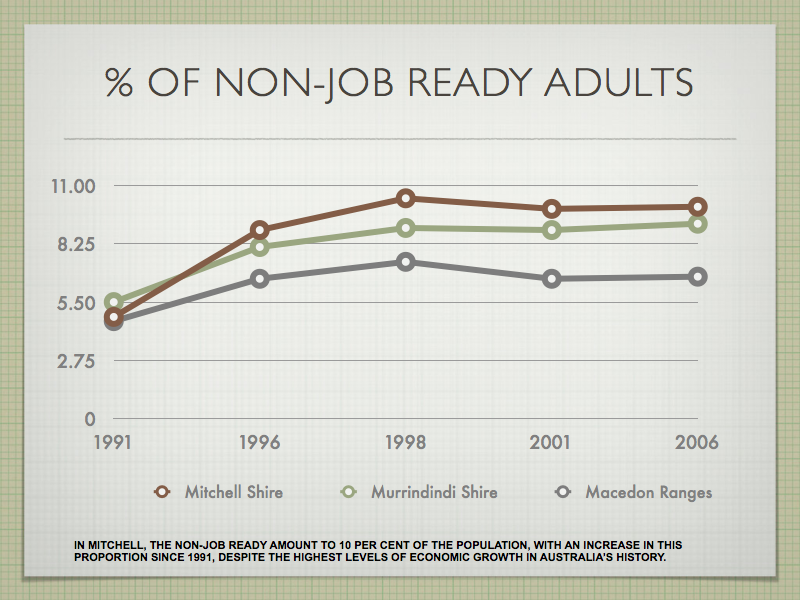An NBN Banana ?
There is NOTHING like access to HIGH-SPEED and RELIABLE broadband infrastructure.

I have NOTHING like access to HIGH SPEED and RELIABLE broadband infrastructure.
A small rant regarding my network access today……
I have been involved, both personally and professionally, in the planning and development of information and telecommunications projects for Education, Business and Communities for almost 30 years. Most recently, my focus has turned to my region and my own needs. This seems as reasonable a case-study as any I have previously seen or worked on.
We understand the links between telecommunications access and income creation. The economic drivers for regions are many, but telecommunications infrastructure is non-negotiable in my view.

I live approximately one-hundred Kilometres from Victoria’s capital city, Melbourne [Australia’s second largest city, soon to be its largest]. As a rural resident, I live on a property without access to copper-based ADSL services [ ADSL + Distance/Loss = Bad ] and have to satisfy myself with wireless technology and services from Telstra that do not come close to those of my friends, colleagues, customers or even competitors.
My day-to-day business, my children’s education and even my community’s connectedness relies on high quality telecommunications infrastructure.
This should be a challenge to all local councillors and prospective State and Federal politicians and/or candidates.
The most recent review of the National Broadband Network [of which I am a supporter] three-year rollout map highlights what I can only describe as the “Central Victorian NBN Banana..”
The current and planned lack of access is obvious. This is a map of planned activity for the next three years. This is not the only such “Banana” in the state, but it is the one that concerns me most at present.
Given the HUGE demographic challenges being faced in this peri-urban region as well as the most recent effects of the catastrophic “Black Saturday” bushfires, I am still at a loss to understand how this region in particular will not be considered for NBN infrastructure to at least beyond 2016-17, if at all?

It is ironic that in an area of Victoria that has worked with State and Federal MP’s that have included, Fran Bailey MP, Marsha Thompson MP, Bill Shorten MP and Stephen Conroy MP as well as regional and local councils for much more than a decade to improve telecommunications and other services [such as gas pipelines], we are no closer to improved broadband infrastructure.
It seems prescient that local organisations [of which I was involved] presented both successive State and Federal Governments with a telecommunications network infrastructure plan, preliminary engineering and business case ELEVEN years ago.
The map below, which matches my “NBN Banana” was a logical network outline presented to both State and Federal Governments nine years ago – pre NBN…and was the basis of planning for a number of years by both local councils and related organisations.
This was euphemistically called a community of integrated networks or “C.O.I.N’s”

Why a Community of Integrated Networks [C.O.I.N.’s]?
*This section is a copy of originals published by the Central Ranges Local Learning & Employment Network in 2004
When the most detailed socio-economic scan of the Macedon, Mitchell and Murrindindi shires was completed in March 2004, it highlighted little if any coordination of education provision with health, youth or other services.
A number of communities within this region demonstrated some of the highest rates of youth disengagement [and associated social and economic problems] in the state. This was combined with labour-market dynamics that suggested a large section of the population was loosing ground in all areas of employment and training outcomes at a time when the nation was growing strongly.
The percentage of non-job ready adults was growing alarmingly, well beyond comparable regions.

A cross-sectoral and community alliance of local and regional providers already existed and was working to develop strategic initiatives designed to reform programme and service delivery to the communities they served.
At the time [2004] an alliance was formed between local governments, local progress associations and the Central Ranges Local Learning and Employment Network Inc to lobby Governments for improved telecommunications infrastructure.
The Objectives of the network were:
- To improve the outcomes for young people entering the work-force or further study.
- To improve the skills available in local communities.
- To reduce the recurring costs of modern communications to agencies in the region
- To improve the range of services and applications available to communities in these areas
- To provide infrastructure that can be used as an attractor for higher levels of education and training
- To promote collaboration between existing organisations with overlapping requirements and resources
- To provide mechanisms by which communities and local economies can promote regional skills, both internally to the communities and externally to the rest of Australia and the world
The network was intended to provide services to a range of agencies, communities and individuals in the region, including:
- Primary, Secondary and Tertiary education organisations;
- Healthcare agencies;
- Vocational training agencies; and
- Community and youth agencies such as libraries to name just a few.
There were some relevant case studies that demonstrated the effectiveness of this type of collaboration. These included:
The Gippsland Education Precinct; and
Many similar networks existed. The goal was to create a series of bridges between existing networks and build capability, particularly in our smaller communities, with a view to synchronizing and expanding delivery right across the learning needs of our communities and our local economies.
[End of 2004 reprint]An NBN Banana ? Can we peel it or make fruit salad?
Eleven years on and this can only be described as a failure for our [my] region.
Given the the hundreds if not thousands of hours that have been devoted by many many community and regional groups to improve broadband access for the region, it appears we are left with the “NBN Banana”.
This situation is not good for my business, as everything I do, based on my telecommunications access, is at least a factor of FIVE more expensive and a factor of TEN slower than my colleagues, clients and competitors. Even within small geographic areas, the inequity of access to such services is substantial and profound. This applies equally to the services, businesses and regional development opportunities that would or could be based around appropriate telecommunications infrastructure.
The situation for education and training providers, for those seeking to improve their skills and access to online services [because of distance and cost] also face the same structural inequality built in to our local economy.
The extrapolation of such a small case study for strategic regional and national development is clear.
In a Federal election year, rural and regional telecommunications infrastructure needs to be a major strategic priority.
At a local level, regional and council representatives need to re-consider the implications for our local economies, now and in to the future and should consider re-establishing the strategic imperative around telecommunications and consider “getting the band back together”, the alliance of numerous community organisations that worked so hard to make broadband access a priority for our region.
Let’s hope we don’t slip on the peel…

